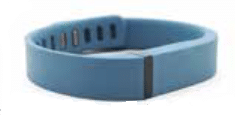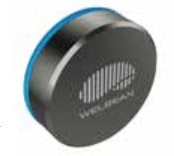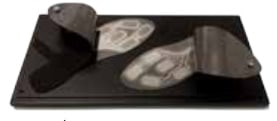
Fitness Technology That Shakes Things Up
For me, the annual Consumer Electronics Show combines the joy of Christmas morning with the wonder of Willy Wonka's chocolate factory. The massive Las Vegas trade show surrounds me with the bells and whistles of the latest and greatest technologies from around the world, with booth after booth full of people showing me why their products will be the next game changer in the health-and-fitness industry.
One of the biggest buzzwords among today's would-be game changers is "disruption"—new technology that promises to shake up an entire industry. With that in mind, I offer you my CES List of Disruptive Health Technologies for 2017. The list is by no means complete; rather, it reviews the gadgets and gizmos that made me think, "They could be on to something."
Fitbit®
Last year, Fitbit made a big splash with the launch of the Blaze™ and with updates to nearly all of its wearables. At CES 2017, the news shifted from new devices to new service offerings. CEO James Park said Fitbit wants to release an app store as soon as possible. Park noted that "an app store would be especially helpful as Fitbit tries to extend its relationships with employers and health care companies that are using Fitbits for corporate wellness programs."
Outlook for fitness pros. It's welcome news that one of the major players in the wellness wearables industry wants to enhance its platform in ways that will combine technology and the expertise of human touch through a trainer or coach. Fitness professionals will have the ability to combine different apps with different purposes by using a Fitbit as the hub for all health and fitness activity.
Under Armour®
Under Armour is targeting athletes with an update of its "Record" app and an entry in the sleep-and-recovery space. In a keynote talk, CEO Kevin Plank announced that Under Armour's digital health and fitness community now has more than 190 million members (for comparison, the International Health, Racquet & Sportsclub Association reports that 55.3 million people were members of a health club in the United States in 2016). Plank also talked about how the apparel and shoe giant will use collected data to shape both the company and our lifestyles in the years to come.
Additions to the Under Armour Record™ app include a science-based sleep and recovery system (rumored to be the brainchild of New England Patriots quarterback Tom Brady) and the new connected UA running shoes ($140–$160), with a Jump Test that aims to tell clients whether to run hard, take it easy or keep an even pace, based on their test performance.
Outlook for fitness pros. Coaches and trainers who work with a sports population may find a lot to like about Under Armour's platform—though the technology is on the expensive side.
Mio® Slice
Heart rate monitoring company Mio has a new all-day heart rate and activity tracker that ditches the measurement of steps. Instead, it creates a "fitness number" based on what it calls personal activity intelligence. PAI uses heart rate as "the single most accurate reflection of your body's response to physical activity."
The device generates a PAI score that gives actionable feedback based on heart rate. The goal is for clients to maintain optimal health by keeping their PAI score above 100 over a rolling 7-day window.
Outlook for fitness pros. If you'd like to differentiate yourself from the crowd and help clients try a different metric than number of steps taken, the Mio Slice's PAI score might be what you are looking for.
New Heart Health Devices
New and improved heart health devices launched at CES 2017 touted the ability to track a broad range of heart measures. These are a few that I am keeping an eye on for 2017:
Welbean Heartscope
The Welbean Heartscope is a heart performance monitor that may help people understand their heart conditions, reduce the risk of heart disease and identify possible heart problems early. It measures and analyzes heart signals by using medical-grade smart sensors, sophisticated digital signal processing (DSP) algorithms, and intelligent health and medical knowledge systems.
In addition to heart rate, Welbean Heartscope measures heart contractility (the strength and workload of heart muscles), heart motility (the flexibility of heart muscles) and the stress placed upon the heart. The company suggests that Welbean Heartscope's contractility monitoring provides more scientific data, more guidance and potentially more motivation for cardiovascular workouts.
MOCAheart
MOCAheart is an award-winning smart biosensor that promises to make tracking cardiovascular health easier by removing the need for cuffs and wires.
By scanning the user's thumb and then connecting to the companion app for iOS and Android, MOCAheart measures three important heart health indicators: heart rate; blood oxygen; and pulse wave velocity, which measures arterial stiffness. The medical community has long considered PWV an indicator of cardiovascular health and risks of hypertension, high cholesterol, organ failure, stroke and heart attack.
MOCAheart takes into account many everyday lifestyle habits, including exercise, diet and sleep. Smaller than a credit card, the device aims to provide a reliable and intuitive way for clients to understand their health data and see how lifestyle changes can affect their health.
Outlook for fitness pros. If you specialize in working with clients who have heart trouble or who are interested in reducing their risk of a heart problem, you might benefit from new ways to track and share information about heart health. Remember to stay within your scope of practice as a trainer or coach, and refer clients who need additional testing or follow-up to one of your trusted healthcare partners.
Running Tech
I saw a lot of interesting technology for runners at CES 2017. Devices offer new ways to track, measure and educate runners on what they are doing right and what they can do to avoid trouble in the future. I'm choosing these two companies for more testing and review:
Lumo Run
Lumo Run evaluates clients' running form with a small, discreet wearable sensor that clips to the back of their running shorts (clip included with purchase). The Lumo Run sensor is a lab-grade nine-axis sensor with advanced algorithms to capture accurate running biomechanics through core body movements. The device assesses cadence, braking, bounce, pelvic rotation and pelvic drop after a 10-minute run.
After the assessment, the built-in audio coach gives real-time, in-run tips on the five running metrics. When the client has finished, the device delivers a detailed postrun summary, including an analysis of running form and performance.
Arion
Whether clients are new to running, plagued by injury or frustrated by performance plateaus, the solution is to adapt their running technique. However, many trainers and coaches lack the expertise to help clients make these adaptations.
Enter Europe-based Arion—an ultra-thin, intelligent insole that slips neatly into running shoes. The Arion system breaks running technique into essential pieces and provides live feedback that allows runners to understand, adapt and rebuild their running technique in a way that has never been possible before.
Outlook for fitness pros. We've been able to measure some running factors for decades, but until recently the measurements were expensive to obtain so usually they were available only to elite athletes. These new technologies let trainers and coaches offer insights into running biomechanics that can help clients run longer with less stress on their bodies.
Recovery Tools
Finally, measurement and recovery technologies were abundant at CES 2017. Recovery devices aim to allow people to exercise just enough and rest for a proper amount of time before engaging in another round of exercise. These two companies made my short list of fitness technology to watch for measurement and recovery:
G-VERT™
Florida-based VERT®, known for jump measurement technology, announced a new wearable that can measure movements, track the intensity of a workout and provide analytics that could prevent injuries. G-VERT also measures a workout's impact on the athlete's body and the g-force of movements, providing insights such as these:
- stress percentage—the low and high intensities of each movement, and the total stress placed on the body or the appendage
- power—how much power the client exerted, and how explosive the movements were, in watts per pound
- energy—how hard the client worked, in joules/pound
- jump—how many times the client jumped, and how high the vertical jump was
- asymmetry—the client's body symmetry for peak athletic performance
Hyperice®
Hyperice builds portable sports medicine and orthopedic devices that can provide preventive treatment, accelerate injury recovery, and enhance muscle and joint performance. Its signature product is a two-part ice compression system, composed of an ultra-thin ice cell with air-release technology joined to a compression wrap designed for each of the body's major muscles and joints. Hyperice targets elite athletes and major rehabilitation facilities around the world.
Outlook for fitness pros. I see great potential in trainers and coaches being able to test clients outside the gym or lab. Technology like the G-VERT allows that to happen wherever and whenever it's needed. And after a workout, products such as Hyperice can provide clients with the type of recovery that professional and elite athletes have used for years, now made portable and more affordable for all users.
Any of the items on my 2017 CES List of Disruptive Health Technologies could do some good for coaches and trainers. Better tools give you a chance to work smarter while helping your clients hit their fitness goals.








